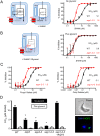Aquaglyceroporin-null trypanosomes display glycerol transport defects and respiratory-inhibitor sensitivity
- PMID: 28358927
- PMCID: PMC5388498
- DOI: 10.1371/journal.ppat.1006307
Aquaglyceroporin-null trypanosomes display glycerol transport defects and respiratory-inhibitor sensitivity
Abstract
Aquaglyceroporins (AQPs) transport water and glycerol and play important roles in drug-uptake in pathogenic trypanosomatids. For example, AQP2 in the human-infectious African trypanosome, Trypanosoma brucei gambiense, is responsible for melarsoprol and pentamidine-uptake, and melarsoprol treatment-failure has been found to be due to AQP2-defects in these parasites. To further probe the roles of these transporters, we assembled a T. b. brucei strain lacking all three AQP-genes. Triple-null aqp1-2-3 T. b. brucei displayed only a very moderate growth defect in vitro, established infections in mice and recovered effectively from hypotonic-shock. The aqp1-2-3 trypanosomes did, however, display glycerol uptake and efflux defects. They failed to accumulate glycerol or to utilise glycerol as a carbon-source and displayed increased sensitivity to salicylhydroxamic acid (SHAM), octyl gallate or propyl gallate; these inhibitors of trypanosome alternative oxidase (TAO) can increase intracellular glycerol to toxic levels. Notably, disruption of AQP2 alone generated cells with glycerol transport defects. Consistent with these findings, AQP2-defective, melarsoprol-resistant clinical isolates were sensitive to the TAO inhibitors, SHAM, propyl gallate and ascofuranone, relative to melarsoprol-sensitive reference strains. We conclude that African trypanosome AQPs are dispensable for viability and osmoregulation but they make important contributions to drug-uptake, glycerol-transport and respiratory-inhibitor sensitivity. We also discuss how the AQP-dependent inverse sensitivity to melarsoprol and respiratory inhibitors described here might be exploited.
Conflict of interest statement
The authors have declared that no competing interests exist.
Figures





Similar articles
-
Melarsoprol sensitivity profile of Trypanosoma brucei gambiense isolates from cured and relapsed sleeping sickness patients from the Democratic Republic of the Congo.PLoS Negl Trop Dis. 2014 Oct 2;8(10):e3212. doi: 10.1371/journal.pntd.0003212. eCollection 2014 Oct. PLoS Negl Trop Dis. 2014. PMID: 25275572 Free PMC article.
-
Chimerization at the AQP2-AQP3 locus is the genetic basis of melarsoprol-pentamidine cross-resistance in clinical Trypanosoma brucei gambiense isolates.Int J Parasitol Drugs Drug Resist. 2015 May 7;5(2):65-8. doi: 10.1016/j.ijpddr.2015.04.002. eCollection 2015 Aug. Int J Parasitol Drugs Drug Resist. 2015. PMID: 26042196 Free PMC article.
-
Aquaporin 2 mutations in Trypanosoma brucei gambiense field isolates correlate with decreased susceptibility to pentamidine and melarsoprol.PLoS Negl Trop Dis. 2013 Oct 10;7(10):e2475. doi: 10.1371/journal.pntd.0002475. eCollection 2013. PLoS Negl Trop Dis. 2013. PMID: 24130910 Free PMC article.
-
Drug resistance in African trypanosomiasis: the melarsoprol and pentamidine story.Trends Parasitol. 2013 Mar;29(3):110-8. doi: 10.1016/j.pt.2012.12.005. Epub 2013 Jan 30. Trends Parasitol. 2013. PMID: 23375541 Free PMC article. Review.
-
Melarsoprol Resistance in African Trypanosomiasis.Trends Parasitol. 2018 Jun;34(6):481-492. doi: 10.1016/j.pt.2018.04.002. Epub 2018 Apr 25. Trends Parasitol. 2018. PMID: 29705579 Review.
Cited by
-
Positively selected modifications in the pore of TbAQP2 allow pentamidine to enter Trypanosoma brucei.Elife. 2020 Aug 11;9:e56416. doi: 10.7554/eLife.56416. Elife. 2020. PMID: 32762841 Free PMC article.
-
Differences in Transporters Rather than Drug Targets Are the Principal Determinants of the Different Innate Sensitivities of Trypanosoma congolense and Trypanozoon Subgenus Trypanosomes to Diamidines and Melaminophenyl Arsenicals.Int J Mol Sci. 2022 Mar 5;23(5):2844. doi: 10.3390/ijms23052844. Int J Mol Sci. 2022. PMID: 35269985 Free PMC article.
-
Systematic Review and Meta-Analysis on Human African Trypanocide Resistance.Pathogens. 2022 Sep 25;11(10):1100. doi: 10.3390/pathogens11101100. Pathogens. 2022. PMID: 36297157 Free PMC article. Review.
-
Potent Antitrypanosomal Activities of 3-Aminosteroids against African Trypanosomes: Investigation of Cellular Effects and of Cross-Resistance with Existing Drugs.Molecules. 2019 Jan 12;24(2):268. doi: 10.3390/molecules24020268. Molecules. 2019. PMID: 30642032 Free PMC article.
-
Aquaporin 1 is located on the intestinal basolateral membrane in Toxocara canis and might play a role in drug uptake.Parasit Vectors. 2019 May 17;12(1):243. doi: 10.1186/s13071-019-3500-1. Parasit Vectors. 2019. PMID: 31101125 Free PMC article.
References
-
- Priotto G, Kasparian S, Mutombo W, Ngouama D, Ghorashian S, et al. (2009) Nifurtimox-eflornithine combination therapy for second-stage African Trypanosoma brucei gambiense trypanosomiasis: a multicentre, randomised, phase III, non-inferiority trial. Lancet 374: 56–64. 10.1016/S0140-6736(09)61117-X - DOI - PubMed
Publication types
MeSH terms
Substances
Grants and funding
LinkOut - more resources
Full Text Sources
Other Literature Sources

